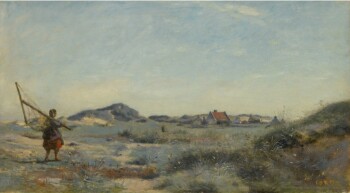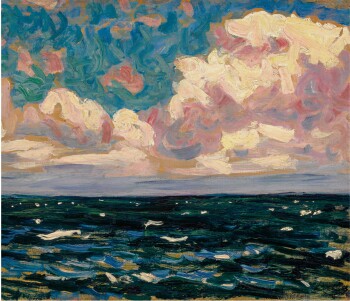D uring the nineteenth century, painters from across Europe sought inspiration in their natural surroundings, from the verdant Forest of Fontainebleau and majestic Danube river to the rolling, quiet hills of Denmark. At a time of increasing urbanization in major cities such as Paris, Stockholm and Copenhagen, these artists turned to nature for solace and refuge from modern life.
"Beauty in art is truth bathed in an impression received from nature. I am struck upon seeing a certain place. While I strive for conscientious imitation, I yet never for an instant lose the emotion that has taken hold of me."
Building on the work of landscape painters from previous centuries, such as the masters of the Dutch Golden Age and Joseph Mallord William Turner, these artists elevated the genre and brought it into a new age.
Below you will find examples of 19th century landscapes by French, English, Irish, Swedish and Danish painters to be offered in the 19th Century European Art auction on 31 January.
- Jean-Baptiste-Camille Corot, 1857
- Jean-Baptiste-Camille Corot, circa 1865
- Gustave Courbet, 1869
- Charles-François Daubigny, 1873
- Gustave Courbet, circa 1875
- John Atkinson Grimshaw, 1878
- August Strindberg, 1894
- Roderic O’Conor, 1898
- Vilhelm Hammershøi, circa 1904
-
 Jean-Baptiste-Camille Corot, 1857In September 1857, Jean-Baptiste-Camille Corot traveled to Dunkirk, a coastal town near the border of France and Belgium. There Corot painted at least ten oils, the present work included, of Dunkirk’s dunes, fishermen and large harbor.
Jean-Baptiste-Camille Corot, 1857In September 1857, Jean-Baptiste-Camille Corot traveled to Dunkirk, a coastal town near the border of France and Belgium. There Corot painted at least ten oils, the present work included, of Dunkirk’s dunes, fishermen and large harbor.
(left) Jean-Baptiste-Camille Corot, Dunkerque. Une pêcheuse de crevettes, 1857. Estimate $120,000 – 180,000.
View Lot -
 Jean-Baptiste-Camille Corot, circa 1865Jean-Baptiste-Camille Corot, the master landscape artist of the Barbizon school, played a major role in elevating and furthering the genre of landscape painting in France. In addition to his beloved Barbizon, Corot also traveled abroad. In 1843, he visited Lake Nemi, a picturesque lake south of Rome. The present work is a souvenir, a work painted from memory in Corot’s studio long after the Italian landscape was visited.
Jean-Baptiste-Camille Corot, circa 1865Jean-Baptiste-Camille Corot, the master landscape artist of the Barbizon school, played a major role in elevating and furthering the genre of landscape painting in France. In addition to his beloved Barbizon, Corot also traveled abroad. In 1843, he visited Lake Nemi, a picturesque lake south of Rome. The present work is a souvenir, a work painted from memory in Corot’s studio long after the Italian landscape was visited.
(left) Jean-Baptiste-Camille Corot, Souvenir du Lac de Némi. Bataliers à la rive, circa 1865. Estimate $120,000 – 180,000.
View Lot -
 Gustave Courbet, 1869Gustave Courbet loved the ocean. Édouard Manet named him “the Raphael of water. He knows all its movements, whether deep or shallow, at every time of day.” He began painting his earliest seascapes on the coast of Normandy in 1841, and they became a central and highly important focus of his oeuvre. Courbet employed the use of a palette knife to mix dark, deep blues and hints of white to create the effects of tumultuous, restless sea.
Gustave Courbet, 1869Gustave Courbet loved the ocean. Édouard Manet named him “the Raphael of water. He knows all its movements, whether deep or shallow, at every time of day.” He began painting his earliest seascapes on the coast of Normandy in 1841, and they became a central and highly important focus of his oeuvre. Courbet employed the use of a palette knife to mix dark, deep blues and hints of white to create the effects of tumultuous, restless sea.
(left) Gustave Courbet, La mer orageuse, 1869. Estimate $500,000 – 700,000.
View Lot -
 Charles-François Daubigny, 1873The present work, with its delicate blooms, jewel-like blue sky and verdant landscape, accurately captures spring’s rebirth. Charles-François Daubigny first began painting apple orchards in bloom in 1857. Vincent Van Gogh, who constantly experimented with rendering the changing of the seasons, was particularly fascinated with Daubigny’s spring orchards, and they inspired a number of his own landscapes.
Charles-François Daubigny, 1873The present work, with its delicate blooms, jewel-like blue sky and verdant landscape, accurately captures spring’s rebirth. Charles-François Daubigny first began painting apple orchards in bloom in 1857. Vincent Van Gogh, who constantly experimented with rendering the changing of the seasons, was particularly fascinated with Daubigny’s spring orchards, and they inspired a number of his own landscapes.
(left) Charles-François Daubigny, Les pommiers en fleur, 1873. Estimate $50,000 – 70,000.
View Lot -
 Gustave Courbet, circa 1875In 1873, Gustave Courbet arrived in Switzerland after incurring large debts following his implication in the destruction of the Vendôme column. He was drawn to the Château de Chillon, located on the edge of Lake Geneva, and this structure would be a reoccurring feature in a number of his compositions. This particular view emphasizes the château’s connection to the rocky beach in the foreground and the distant snowy peaks of the Alps.
Gustave Courbet, circa 1875In 1873, Gustave Courbet arrived in Switzerland after incurring large debts following his implication in the destruction of the Vendôme column. He was drawn to the Château de Chillon, located on the edge of Lake Geneva, and this structure would be a reoccurring feature in a number of his compositions. This particular view emphasizes the château’s connection to the rocky beach in the foreground and the distant snowy peaks of the Alps.
(left) Gustave Courbet, Château de Chillon, circa 1875. Estimate $300,000 – 400,000.
View Lot -
 John Atkinson Grimshaw, 1878John Atkinson’s Grimshaw’s crepuscular A Yorkshire Home is emblematic of the mystery, melancholy and nostalgia so often found in the artist’s work. Living in Knostrop Hall near Leeds during the 1870s, Grimshaw was inspired by his home’s natural surroundings as well as the moody and mysterious poems of Alfred Tennyson, which also centered around themes of solitude, overgrown nature and nighttime.
John Atkinson Grimshaw, 1878John Atkinson’s Grimshaw’s crepuscular A Yorkshire Home is emblematic of the mystery, melancholy and nostalgia so often found in the artist’s work. Living in Knostrop Hall near Leeds during the 1870s, Grimshaw was inspired by his home’s natural surroundings as well as the moody and mysterious poems of Alfred Tennyson, which also centered around themes of solitude, overgrown nature and nighttime.
(left) John Atkinson Grimshaw, A Yorkshire Home, 1878. Estimate $350,000 – 500,000.
View Lot -
 August Strindberg, 1894August Strindberg, the celebrated Swedish painter, playwright, alchemist and poet, visited Dornach, Austria in 1894, where he painted a series of emotionally charged, semi-abstracted landscapes. This work, which depicts the Danube dramatically flooding its banks, draws upon Strindberg’s scientific theory of “monism” by depicting sky, water and land as blended into one with animated bursts of color.
August Strindberg, 1894August Strindberg, the celebrated Swedish painter, playwright, alchemist and poet, visited Dornach, Austria in 1894, where he painted a series of emotionally charged, semi-abstracted landscapes. This work, which depicts the Danube dramatically flooding its banks, draws upon Strindberg’s scientific theory of “monism” by depicting sky, water and land as blended into one with animated bursts of color.
(left) August Strindberg, Översvämning vid Donau (Flood on the Danube), 1894. Estimate $600,000 – 800,000.
View Lot -
 Roderic O’Conor, 1898Irish painter Roderic O’Conor traveled extensively in Brittany throughout the 1890s, during which time he became a close acquaintance of the Post-Impressionist Paul Gauguin, who was equally fascinated with the Breton coast. In 1898, the year the present lot was completed, O’Conor traveled to Belle-Île, a remote island off the southwestern coast of Brittany where Claude Monet had painted a series of seascapes a decade prior. Here the artist has used broad, energetic brushstrokes to suggest the effects of sea breeze.
Roderic O’Conor, 1898Irish painter Roderic O’Conor traveled extensively in Brittany throughout the 1890s, during which time he became a close acquaintance of the Post-Impressionist Paul Gauguin, who was equally fascinated with the Breton coast. In 1898, the year the present lot was completed, O’Conor traveled to Belle-Île, a remote island off the southwestern coast of Brittany where Claude Monet had painted a series of seascapes a decade prior. Here the artist has used broad, energetic brushstrokes to suggest the effects of sea breeze.
(left) Roderic O’Conor, Breeze, 1898. Estimate $70,000 – 100,000.
View Lot -
 Vilhelm Hammershøi, circa 1904Having spent five years at Strandgade 30, the Copenhagen apartment that was the subject of his most iconic and commercially popular interiors, Vilhelm Hammershøi looked to engage with nature. The artist spent the summer of 1904 in Arresødal, near Frederiksværk, a mid-18th century town. The present work is deceptively complex with its quiet stillness and luminous halos around the curves of the hills and the trees, and it recalls the work of James Abbott McNeill Whistler.
Vilhelm Hammershøi, circa 1904Having spent five years at Strandgade 30, the Copenhagen apartment that was the subject of his most iconic and commercially popular interiors, Vilhelm Hammershøi looked to engage with nature. The artist spent the summer of 1904 in Arresødal, near Frederiksværk, a mid-18th century town. The present work is deceptively complex with its quiet stillness and luminous halos around the curves of the hills and the trees, and it recalls the work of James Abbott McNeill Whistler.
(left) Vilhelm Hammershøi, Dunkebakke. Frederiksværk, circa 1904. Estimate $300,000 – 500,000.
View Lot















